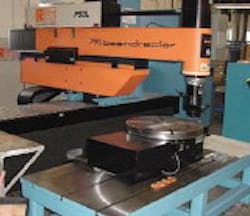EBTEC gets GE-approved for turbine airflow testing
Agawam, MA -- EBTEC Corp. has been approved by General Electric for airflow testing to the conglomerate's Airflow Specification E50TF217, one of only four qualified high-energy beam service providers to achieve the status.
Complex turbine engines for aerospace or ground-based applications require special materials with small hole sizes and hole population densities. For aerospace turbine engine products, this can range from simple round parts with hundreds or thousands of holes, to complex 5-axis geometries with small holes, or simple 2-axis flat-sheet geometries. Measuring and inspecting these tiny holes can be cumbersome and time-consuming.
OEMs are increasingly adopting laser drilling for turbine engines and specific airflow inspection processes. Inspection processes define a specific airflow for each part with high populations of small holes, or parts in the turbine engine's airflow path. The airflow inspection method provides feedback to the drilling process, facilitating the control of the hole sizes. Highly-controlled and targeted airflow parameters allow the turbine engines to operate at defined design efficiencies, and maintain operational temperatures at each of the specific components of the engines.
EBTEC characterized the specifics of the airflow process as measuring the difference in air pressure at the inlet and exit sides of an engine component. At a specified air pressure, the change in pressure (Delta-P) from inlet to exit enables calculation of air flow. (Other relevant values include temperature, humidity, and barometric pressure.)
"These airflow testing processes have matured along with the development of laser systems as machine tools," noted EBTEC VP Mark Hauser, in a statement. EBTEC supports 16 industrial lasers for laser drilling, laser cutting, and laser welding.
